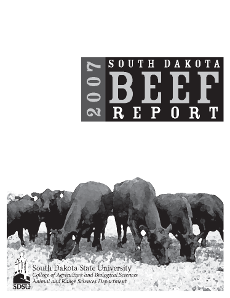Document Type
Report
Report Number
2007-3
Publication Date
2007
Keywords
carbohydrate fermentation, beef cattle, feeding interval, plasma ghrelin concentrations
Summary
Four steers (BW 1281±28.2 lb) were used to determine the relationship of plasma ghrelin concentrations with end-products of carbohydrate fermentation and hormones and metabolites indicative of nutrition status during a 12-h feeding interval. A common high-energy diet was offered at 240% of the intake necessary for BW maintenance (2.4xM) or 80% of the intake necessary for BW maintenance (0.8xM). At initiation of period I, 2 steers were allowed 2.4xM intake, whereas intake for the remaining 2 steers was restricted to 0.8xM. Equal aliquots of feed were offered at 0800 and at 2000 h. On 7, 14, and 21 d following initiation of intake restriction, serial blood samples were collected via indwelling jugular catheter at 15-min intervals through the 12-h feeding interval. Plasma samples were assayed for ghrelin, GH, insulin (INS), and NEFA concentrations. Rumen fluid samples were collected throughout the feeding interval and processed for subsequent analyses of VFA concentrations. Following period I, steers were weighed, dietary treatments were switched between steer groups, intake amounts were recalculated, and sampling period II then was initiated as described for period I. Regardless of amount of DMI, plasma ghrelin and GH concentrations fluctuated as a result of sampling time relative to feeding. Plasma ghrelin concentrations were elevated prior to feeding at 0800 and 2000 h and reached a nadir from 1 and 3 h post-feeding. Although GH was elevated prior to the 0800 h feeding, it was not elevated at 1800 h despite increasing ghrelin concentrations. A tendency for an interaction of dietary treatment by sampling time relative to feeding which indicated an inverse relationship of plasma INS and ghrelin concentrations for cattle in a positive nutrient balance but no relationship between the two hormones when cattle were in negative energy balance. An interaction of dietary treatment by sampling time relative to feeding also resulted for plasma NEFA concentrations. A positive relationship of NEFA and ghrelin concentrations resulted for cattle when energy and protein intake were below the requirement for maintenance of BW. Ruminal VFA concentrations were weakly correlated to plasma ghrelin concentrations. These data are consistent with the hypothesis that, whereas plasma ghrelin concentrations fluctuate with nutritional status of the ruminant animal, the fluctuation is not completely explained by fluctuations in GH, NEFA, INS or ruminal VFA concentrations.
Number of Pages
7
Format
application/pdf
Language
en
Publisher
South Dakota State University
Rights
Copyright © 2007 South Dakota State University
Recommended Citation
Wertz-Lutz, Aimee; Daniel, Jay; Clapper, Jeff; Trenkle, Allen; and Beitz, Donald, "Relationship of Plasma Ghrelin Concentrations with End-Products of Carbohydrate Fermentation for Beef Cattle During a Feeding Interval" (2007). South Dakota Beef Report, 2007. 4.
https://openprairie.sdstate.edu/sd_beefreport_2007/4

